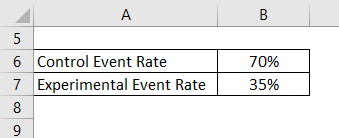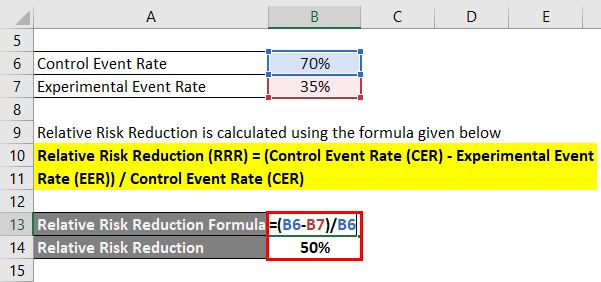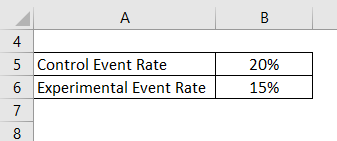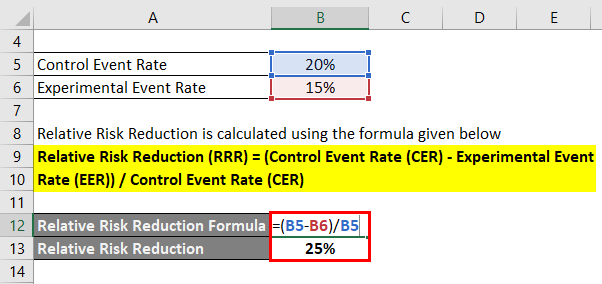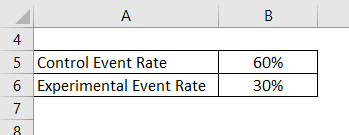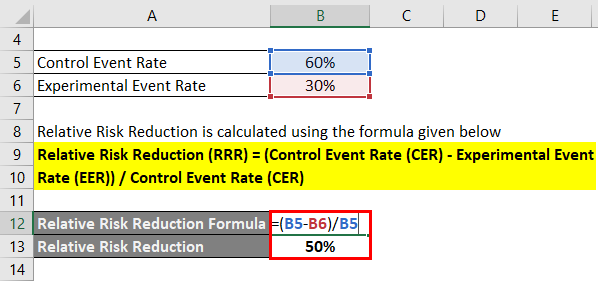Updated July 29, 2023
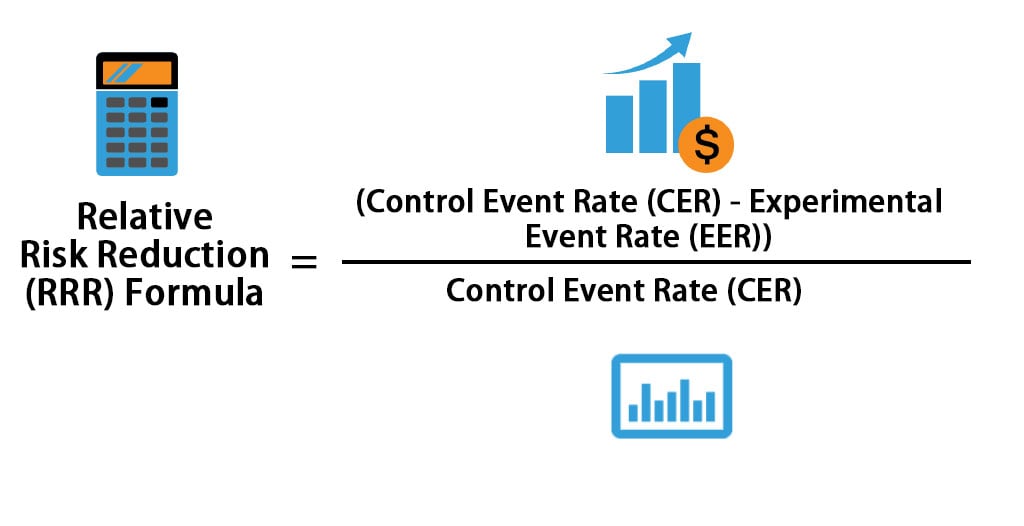
Relative Risk Reduction Formula (Table of Contents)
What is the Relative Risk Reduction Formula?
A risk is a measure of uncertainty. Relative risk reduction talks about an event as the likelihood of happening after exposure to a risk variable compared to the occurrence of the same event in a controlled or a reference group. Risk reduction can alternatively be defined as the difference in the occurrence of an event when compared between two sets of groups which are expressed in contrast as the proportion of an untreated group.
The groups taken in relative risk reduction often remain constant across the given population set with a different underlying set of risks. Therefore, the concept of relative risk reduction is more accurate and expressive when compared to the concept of absolute risk. Also, the lower the event rate in the control group, the larger the difference between relative and absolute risk reduction.
The formula for Relative Risk Reduction –
When the event has a relative risk reduction of greater than 1, the risk of the outcome is then stated as an increase by the treatment. On the other hand, when the risk of treatment is lower than 1, the risk of a bad outcome has been decreased, meaning that the treatment conducted positively impacted the experimental group of people and individuals. A Relative Risk Reduction of 1 means that the risk of the event is identical in the exposed and the control samples.
Examples of Relative Risk Reduction Formula (With Excel Template)
Let’s take an example to understand the calculation in a better manner.
Example #1
FIC Institute of medical research conducted an experiment to Control Event Rate Compared Treatment to a new Chemo drug that was recently launched. 70% of the control group died, and 35% of the experimental group died. Calculate the Relative Risk Reduction for the new chemo drug introduced.
Solution:
The formula to calculate Relative Risk Reduction is as below:
Relative Risk Reduction (RRR) = (Control Event Rate (CER) – Experimental Event Rate (EER)) / Control Event Rate (CER)
- Relative Risk Reduction = (70% – 35%) / 70%
- Relative Risk Reduction = 50%
So the Relative Risk Reduction is 50%. The interpretation of this study is that The death rate in the experimental group is almost half that of the control group. It tells you about the reduction of medical intake in the experimental group. Relative risk reduction is a convenient way of re-expressing a risk ratio as a percentage reduction.
Example #2
The Medical Institute of the United States of America conducted an experiment for Neuropathy. The experiment states that if 20% of the people die with the treatment of Neuropathy. And 15% die with treatment Control Event Rate and then calculate the relative risk reduction.
Solution:
Relative Risk Reduction (RRR) = (Control Event Rate (CER) – Experimental Event Rate (EER)) / Control Event Rate (CER)
- Relative Risk Reduction = (20% – 15%) / 20%
- Relative Risk Reduction = 25%
The risk of treatment is lower than 1, and the risk of a bad outcome has decreased. Hence, the treatment of Neuropathy positively affects the individual’s healing.
Example #3
According to the DDT Data of the United Kingdom, 60% of the control group died of Chemotherapy, and 30% of the treated group died of the same. Therefore, calculate and interpret the Relative Risk Reduction of the above problem.
Solution:
Relative Risk Reduction (RRR) = (Control Event Rate (CER) – Experimental Event Rate (EER)) / Control Event Rate (CER)
- Relative Risk Reduction = (60% – 30%) / 60%
- Relative Risk Reduction = 50%
It means that it has a positive effect on the experimental group.
Relevance and Uses
Risk measures have the advantage of being stable across populations with different baseline risks and are, for instance, useful when combining the results of different trials in a meta-analysis.
It is widely used in the medical industry to calculate the effect of introducing new medicines and medical practices, which in turn results in improving the medical industry.
Relative Risk Reduction Formula Calculator
You can use the following Calculator
| Control Event Rate (CER) | |
| Experimental Event Rate (EER) | |
| Relative Risk Reduction (RRR) Formula = | |
| Relative Risk Reduction (RRR) Formula = |
|
|
Recommended Articles
This has been a guide to the Relative Risk Reduction formula. Here we discuss how to calculate Relative Risk Reduction along with practical examples. We also provide a calculator with a downloadable Excel template. You may also look at the following articles to learn more –
